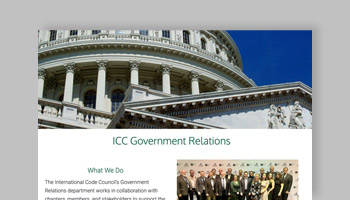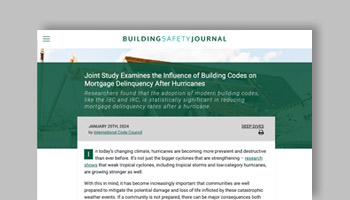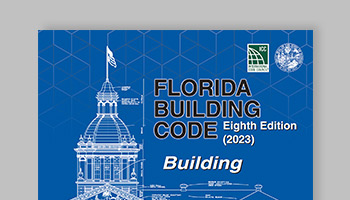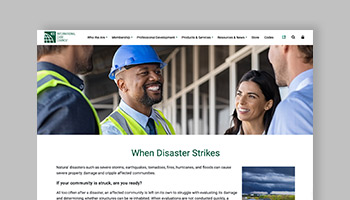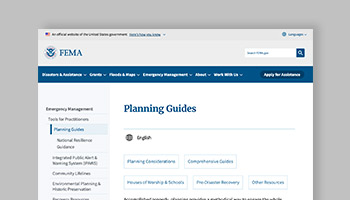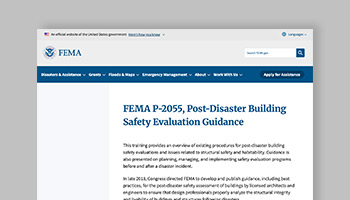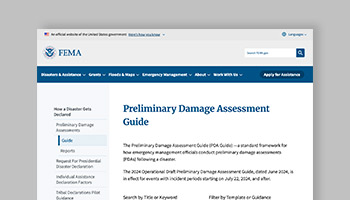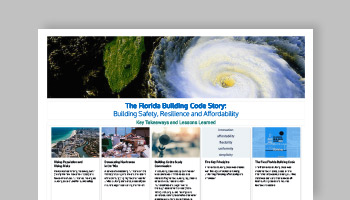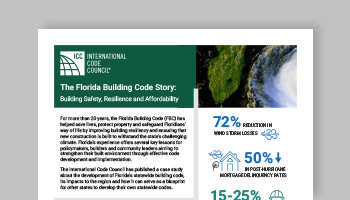
The Florida Building Code Story: Building Safety, Resilience and Affordability
Key Takeaways and Lessons Learned

Rising Population and Rising Risks
Florida is experiencing massive growth (nearly 1M new residents in 2023) and faces 41% of U.S. hurricanes, making its building code crucial for public safety

Devastating Hurricanes in the ‘90s
A series of devastating hurricanes in the 1990s (including Andrew and the "Storm of the Century") highlighted the need for unified building standards, especially as insurers began abandoning the market

Building Codes Study Commission
The Building Codes Study Commission was developed in 1996 to address Florida's fragmented building regulations across 67 counties and 400+ municipalities and began with a thorough assessment phase (1996-1997), including public hearings and panel discussions, to develop criteria for a statewide building code that would protect Floridians

Five Key Principles
The Florida Building Code was created with five key principles: simplicity, uniformity, flexibility, affordability and innovation

The First Florida Building Code
The first Florida Building Code was implemented in 2002, based on the International Codes®, creating a unified statewide standard that replaced all local building codes and required licensed inspectors

Avoiding Over $1 Billion in Annual Losses
The Florida Building Code has proven highly effective, with FEMA estimating Florida avoids over $1 billion in annual losses across 1 million structures due to building damages

Proper Administration and Enforcement
Proper administration and enforcement of the Florida Building Code provides an additional 15-25% reduction in losses, demonstrating the importance of both strong standards and implementation
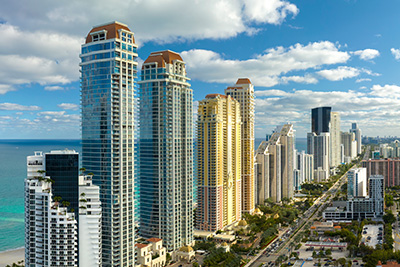
An Enhanced Building Recertification Program
After the Champlain Towers South collapse, Miami-Dade County enhanced its building recertification program, requiring detailed inspections of threshold buildings and implementing new safety measures

Acceptance Through Education and Awareness
Public education and awareness are crucial for building code acceptance, with Florida's commitment to informing residents about code benefits serving as a model for other jurisdictions
If you built to code with new construction, you can withstand hurricanes in Florida.”
—Ron DeSantis, Governor of Florida via
Building Codes: The Florida Resilience Story
The Need for a Statewide Building Code
Florida remains one of the fastest-growing states in America with nearly 1 million people moving there in 2023 alone. Many are attracted to the warm weather and beautiful beaches, but residents also gain the benefits of a statewide building code that was designed to protect the health, safety and welfare of its citizens.
Florida faces 41 percent of U.S. hurricanes and dozens of tornadoes each year, putting its infrastructure and its building codes to the test.
According to the National Oceanic and Atmospheric Administration (NOAA) Office for Coastal Management, natural disasters are occurring more frequently and with greater severity. Between 2020 and 2024, the U.S. experienced 115 weather and climate disasters with damages of more than $1 billion per event.
Per NOAA, total losses (2024) reached $182.7 billion in damages across 27 disasters, exceeding the five-year annual average of 23 events and $149.3 billion in losses.
Florida, in particular, has a long history of devastating hurricanes before the 1990s, including the Great Miami Hurricane (1926), Labor Day Hurricane (1935) and Hurricane Donna (1960), resulting in thousands of fatalities and billions of dollars in damages.
Natural disasters have cost Florida billions of dollars in damage since 1980. Through 2024, the total damage is estimated to have reached:
While these hurricanes were among those that led to the first building codes in Florida, it wasn’t until Hurricane Andrew in 1992 that the state realized it was time for a significant change.
Andrew, another Category 5 hurricane, blasted Florida with 165 mph winds, causing 23 direct deaths and $27 billion in damage. Miami-Dade County’s urban landscape was severely damaged by the storm, which destroyed 25,000 homes (including 99 percent of all mobile homes in the City of Homestead) and left 160,000 residents homeless.
Andrew’s wrath was twofold: in addition to being a particularly intense storm, Florida’s varied collection of building codes and lenient enforcement ($4 billion in insured losses was attributed to Miami-Dade County's poor code enforcement) left residents especially vulnerable. The results were so severe that Florida Governor Lawton Chiles decided it was time to take action.
The Birth of the Florida Building Code: A New Era in Building Safety
With an eye on strong, standardized regulations that would guide Florida’s built environment moving forward, Governor Chiles established the Governor's Building Codes Study Commission in July 1996. The Commission was made up of a balanced group of stakeholders who acted in the interests of the State of Florida as a whole. Dominic Sims, former CEO of the International Code Council, and at the time, Executive Director for Palm Beach County, served the Commission as Vice Chairman.
At the time, Florida had multiple building codes. With 67 counties and more than 400 municipalities doing things their own way, and no overarching code to guide them, enforcement was difficult, and uniformity was impossible.
“This patchwork of regulations was really an obstacle to better and safer building construction,” said Sims.
Without clear guidelines for what they should and should not do throughout the state, builders faced significant variations jurisdiction to jurisdiction.
Few realized the enormity of this problem until Hurricane Andrew and the storms that followed, including the “Storm of the Century” in March 1993. Tropical Storms Alberto and Beryl came a year later in 1994, followed by Hurricane Erin and Hurricane Opal in 1995.
The 28-member Governor’s Building Codes Study Commission included:
- Chairman Tom Lewis, Jr., Vice President of Walt Disney Imagineering
- Vice Chairman Dominic Sims, Executive Director for Palm Beach County
- Pete J. Mitchell, Chief of Staff with the Office of Treasurer and Insurance Commissioner
- Florida Senators Matthew Meadows and Charlie Clary
- Florida Representatives Ken Pruitt and Mary Brennan
- Representatives from several industries, including engineering, building, construction, architecture, real estate, insurance, banking and more
Resiliency Starts with the Florida Building Code
As residents dealt with ongoing damage and the fear of future storms, many insurers abandoned the market, viewing Florida as a losing proposition. Florida’s climate led to a far greater number of claims than anticipated, creating a new problem for Florida residents: they could lose their homes at any time and have no way to pay to rebuild them.
A statewide Building Code was viewed as a solution by creating stronger, more resilient buildings with rules and regulations that are properly enforced.
The Florida Building Code includes codes and provisions from the I-Codes®:
- International Building Code® (IBC®)
- International Residential Code® (IRC®)
- International Fuel Gas Code® (IFGC®)
- International Existing Building Code® (IEBC®)
- International Mechanical Code® (IMC®)
- International Plumbing Code® (IPC®)
The Governor’s Building Codes Study Commission’s criteria for a successful statewide Building Code:
- Be simple to use and clearly understood;
- Be uniform and consistent in its administration and application;
- Be flexible;
- Be affordable; and
- Promote innovation and new technology.
The Commission started with the Assessment Phase (October 1996 – January 1997), which included public hearings, panel discussions and a variety of presentations to inform the best possible decisions. The Commission then evaluated all its information and determined the criteria for a code that would protect the health, safety and welfare of the citizens of Florida.
The Characteristics of an Effective Statewide Building Code
In the aftermath of Hurricane Andrew, the Commission ultimately issued Five Foundations for a Better Built Environment.
The Foundations presented five characteristics for an effective statewide Building Code, which were ultimately adopted:
- A single, statewide Building Code (“The Code”) will be implemented which will govern all technical requirements for Florida's public and private built environment and which will take into account appropriate local variations such as climatic conditions, soil types, termites, weather-related events, risks associated with coastal development, life safety issues and maintenance inspections. The Code will be effective for use statewide, without the need for subsequent adoption by local jurisdictions.
The Florida Building Code is bolstered by several Technical Advisory Committees (TACs) that focus on accessibility, structural, fire, electrical, energy, hurricane research, mechanical, roofing, plumbing and more.
While the Florida Building Code is updated triennially, it may be updated more frequently in accordance with criteria set out in Section 553.73, Florida Statutes.
- Enforcement of The Code will occur solely at the local level with updates accomplished by a newly constituted, independent, state-level Florida Building Code Board (“The Board”) on a three-year cycle. Board members could provide either broad or specialized expertise in the areas of building code enforcement, building material manufacturing, fire prevention, life safety, finance, property insurance or general business. Local governments will have the ability to address local and regional concerns through an amendments process.
- To ensure strong consistency, decisions of local Officials or Boards of Appeal will be reviewable by The Board, and The Board will have the power to issue Binding Interpretations.
- There will be a strengthened Enforcement and Compliance Program, based on a clear and precise definition of roles and responsibilities for all participants in the System and reinforced with expanded education, training and discipline.
- There will be a strong Product Evaluation and Approval Process which is responsible, but streamlined and affordable and which will promote innovation and new technology.
During the development process, the Commission conducted monthly meetings in various locations in Florida and allowed time for public input and comment.
The trend of public input continues to this day with two 45-day public comment periods during the development of each three-year code cycle.
The Florida Building Code Saves Lives, Protects Property and Reduces Insurance Claims
The first Florida Building Code (FBC) was adopted in 2001 and implemented on March 1, 2002. Based on the International Codes® (I-Codes), the FBC superseded all local building codes, putting an end to the era of confusion and inadequate enforcement. From this point forward, all stakeholders had a clear understanding of what they needed to do in order to achieve compliance.
This includes manufacturers, which now had instructions on what they needed to do to produce compliant products. These instructions are critical to the development of new solutions that will further harden buildings from the next set of hurricanes.
Florida also requires building inspectors and plan reviewers to be licensed in each trade they inspect or review.
The Florida Building Code requires new products to be tested by an independent third party to ensure they function as intended.
Hurricane Ian in Florida: A Mitigation Success Story for Building Codes
Following Hurricane Ian, the Code Council, the Federal Emergency Management Agency (FEMA) Mitigation Assessment Team (MAT) and the Florida Department of Emergency Management work together to assess how Florida's building codes performed.
Karl Fippinger, Vice President, Fire and Disaster Mitigation for the International Code Council, visits Fort Myers Beach, FL, to review how older (pre-FBC) homes fared when compared to newer (post-FBC) homes.
The study found that, since the 1980s, the quantity and average total of insurance claims declined significantly with each subsequent decade of building code advancements.
When comparing buildings elevated to comply with modern codes with nonelevated residential buildings, the latter led to more than twice as many claims that cost more than three times as much as homes that were elevated.
Source: FEMA Mitigation Assessment Team Report, Hurricane Ian in Florida.
Florida's Strong Codes Save Lives and Protect Communities
FEMA estimates that Florida building codes help the state avoid more than $1 billion in annual losses across more than one million structures due to building damages.
This estimate includes $911 million in losses associated with hurricane winds across 891,000 structures, and $152 million in avoided losses associated with floods across 150,000 structures.
FEMA's Building Codes Save: A Nationwide Study found that I-Code adoption could help communities avoid between $132B and $171B in cumulative losses through 2040, and $600B+ by 2060.
According to the National Institute of Building Sciences, states and jurisdictions that adopt the latest building code requirements can save up to $11 for every $1 invested. In Florida, additional savings are already apparent.
The FBC is also credited with reducing windstorm losses by up to 72 percent. And by ensuring codes are properly administered and enforced, researchers found an additional loss reduction value on the order of 15 to 25 percent. Additionally, modern building codes decreased the expected spike in post-hurricane mortgage delinquency rates in Florida by about 50 percent.
Prior to Hurricane Ian, researchers estimated that every $1 added to construction costs – to comply with the latest version of the FBC – saved $8 in structural damage.
Addressing Existing Structures
Although updated codes integrate the best practices and the latest science, most buildings were constructed before the FBC came into effect. Protecting occupants within these structures is equally important.
Following the collapse of Champlain Towers South in Surfside, Florida, which caused nearly 100 fatalities, Florida’s leaders took swift action to better assess risks from existing structures. Miami-Dade County quickly updated its building recertification program to require threshold buildings (those with 4+ stories) to be inspected by a structural engineer with experience working on that specific type of building. Random inspections will be conducted to verify that a building's condition matches reports from architects and engineers.
The county also now requires electrical panels to be inspected via thermal imaging and added a façade requirement to evaluate the danger of non-structural components that could become dislodged.
Looking to prevent future tragedies, the National Institute of Standards and Technology (NIST) has spent nearly four years investigating the Surfside incident. As Floridians await NIST’s final report, there are other building safety challenges that must be considered.
As a result, the Code Council assembled experts from Florida and around the county to create the Existing Building Safety Inspection Guideline, which will soon become ICC 1500 Standard for Existing Building Safety Inspection.
The standard will establish the minimum timeframes for condition assessments, therefore enabling the building owners to reasonably maintain their buildings, such that identifiable potential or current unsafe conditions have been noted and remedied.
Sergio Ascunce, Deputy Building Official at Miami-Dade County, expects the changing climate to play a role in future code developments.
“Sea level rise is included in that topic,” said Ascunce. “I think elevating buildings further is going to be something you’re going to look at in the future. In the FBC, we have a one-foot freeboard [above the Base Flood Elevation] that applies across the board to all construction. Could that change to become two or three feet? It’s a possibility. It has to be analyzed carefully.”
“Buildings over three stories that are 30 years old by December 31, 2024, must undergo a recertification inspection, with follow-ups every 10 years. Buildings within three miles of the coastline must be inspected when they reach 25 years by December 31, 2024, and must also comply with inspections every 10 years thereafter. The inspection assesses the integrity of the building’s foundation, load-bearing walls, beams, columns, floors and roofs. If signs of distress, such as cracks, rust, corrosion or deflection, are identified, an additional assessment must be performed.”
The Future of the Florida Building Code
Florida has remained proactive with its implementation and adoption of the FBC. For more than 20 years, the FBC has helped save lives, protect property and safeguard Floridians’ way of life by improving building resiliency and ensuring that new construction is built to withstand Florida’s challenging climate.
As the frequency and severity of storms rises, the need to regularly update adopted codes to keep pace with advancements in technology, lessons learned and best practices will only increase.
That’s why the Florida Building Commission has remained vigilant in updating the FBC every three years while considering new solutions and innovations that could strengthen how buildings are constructed and improved. Their research and continuous updates provide a model for other states and jurisdictions that want to protect residents and businesses against hazards while facilitating economic growth.
What Communities Can Learn from the Florida Building Code
Florida’s experience offers several key lessons for improving building safety and resilience through effective code development and implementation:
- Strong, regularly updated and well-enforced building codes are essential for building safety and resilience;
- The FBC stays effective by continuously incorporating new updates, allowing it to adapt to evolving challenges;
- A statewide code helps unify regulations across disaster-prone regions, making enforcement more efficient and consistent;
- Proper code enforcement is vital to prevent violations that can lead to serious risks for lives and properties;
- Public education and awareness are critical to gaining support for building codes; Florida’s proactive approach serves as a model for other states;
- Ongoing communication with stakeholders ensures smoother implementation and greater compliance with code changes.
More Resources
ICC Government Relations
View website
Modern Building Codes: A Path to Affordable, Resilient Housing
View website
Joint Study Examines the Influence of Building Codes on Mortgage Delinquency After Hurricanes
View article
2023 Florida Building Code, Building, Eighth Edition
View code
When Disaster Strikes
View website
FEMA Planning Guides
View website
FEMA P-2055, Post Disaster Building Safety Evaluation Guide
View website
FEMA Preliminary Damage Assessment Guide
View website
Florida Building Code Story
View pdf





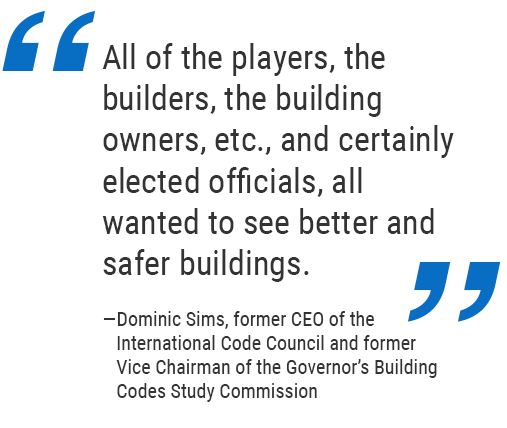
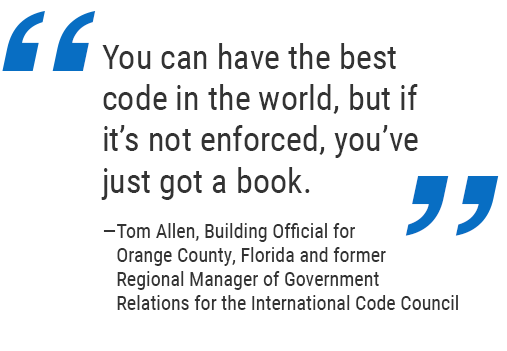


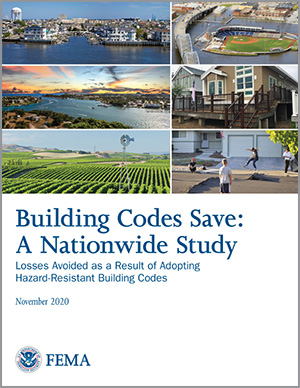
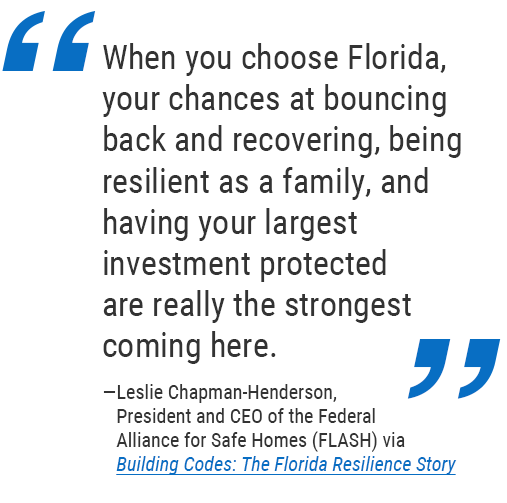
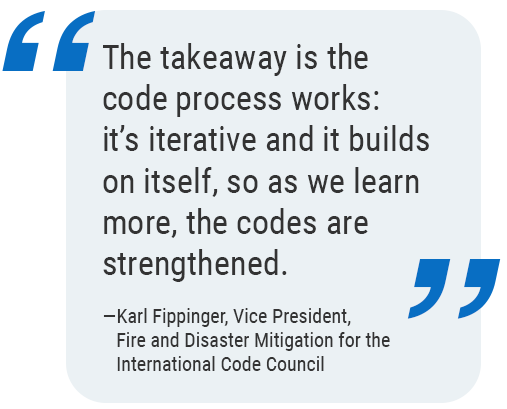
![All you gotta do is see the communities that are built to the [Floria] Building Code and compare those to the ones that aren't, and it's pretty easy to see. you don't have to be a rocket scientist.](https://www.iccsafe.org/wp-content/uploads/25-24845_FL_quote_v1e_JB3.png)
